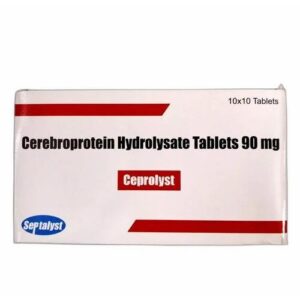PROPRANOLOL + FLUNARIZINE + CEREBROPROTEIN HYDROLYSATE
Propranolol: Propranolol is a medication that belongs to a class of drugs called beta blockers. It is primarily used to treat high blood pressure, angina (chest pain), and certain heart rhythm disorders. Additionally, it is prescribed for the prevention of migraines and the management of symptoms related to anxiety and stage fright.
The mechanism of action of propranolol involves blocking the beta receptors in the body. By doing so, it reduces the effects of adrenaline and other stress hormones on the heart and blood vessels. This helps to lower blood pressure, decrease heart rate, and reduce the workload on the heart. In the case of migraines, propranolol is thought to work by affecting the blood vessels in the brain to prevent migraine attacks.
The dose and frequency of propranolol depend on the condition being treated, its severity, and the individual’s response to the medication. It is usually taken orally and comes in different formulations such as tablets, capsules, and extended-release capsules. It is important to follow the instructions provided by the healthcare professional and not to exceed the prescribed dose.
Common side effects of propranolol may include fatigue, dizziness, lightheadedness, cold hands or feet, nausea, and diarrhea. These side effects are usually mild and go away on their own. However, if they persist or become bothersome, it is recommended to consult a doctor. In some cases, propranolol can also cause more serious side effects such as slow heart rate, low blood pressure, wheezing, and depression. It is important to be aware of any unusual or severe symptoms and seek medical attention if they occur.
Before starting propranolol, it is crucial to inform the healthcare professional about any pre-existing medical conditions, ongoing medications, or allergies, as they may interact with this drug. Propranolol should be used with caution in individuals with asthma, diabetes, heart problems, or liver or kidney disease.
It is essential to note that the information provided here is a general overview. The specific dosage and usage instructions for propranolol may vary depending on the individual and their medical condition. It is necessary to consult a healthcare professional for personalized advice and recommendations.
Flunarizine: Flunarizine is a drug that belongs to the class of calcium channel blockers. It is primarily used for the prevention of migraine headaches and also for the treatment of vestibular disorders such as vertigo and Meniere’s disease.
The mechanism of action of Flunarizine involves blocking the entry of calcium ions into the smooth muscle cells and neurons. By doing so, it helps to relax and widen the blood vessels in the brain, which reduces the frequency and severity of migraines. In vestibular disorders, Flunarizine has a suppressive effect on the inner ear, reducing vestibular tone and decreasing vertigo symptoms.
The recommended dose of Flunarizine varies depending on the condition being treated. For the prevention of migraines, the usual starting dose is 5-10 mg per day, which can be gradually increased up to 20 mg per day if needed. For vestibular disorders, a dose of 5-10 mg per day is commonly prescribed.
Like any medication, Flunarizine can have side effects. Common side effects may include drowsiness, weight gain, and increased appetite. Other possible side effects include depression, parkinsonism-like symptoms (tremors, stiffness), movement disorders, and extrapyramidal symptoms. Flunarizine may also cause liver changes, so regular liver function monitoring is necessary during treatment. Additionally, rare but serious side effects such as suicidal thoughts, allergic reactions, or abnormal heart rhythm have been reported, and if any of these occur, immediate medical attention should be sought.
As with any medication, it is important to consult with a healthcare professional before starting Flunarizine to ensure it is appropriate for your specific condition and to discuss the potential side effects and risks.
Cerebroprotein Hydrolysate: Cerebroprotein Hydrolysate, also known as Cerebrolysin, is a drug derived from the brain tissue of pigs. It is used for the treatment of various neurological disorders and brain injuries.
The exact mechanism of action of Cerebroprotein Hydrolysate is not fully understood. It is believed to have neuroprotective and neurotrophic effects, meaning it helps protect and promote the growth of nerve cells in the brain. It is thought to enhance neuroplasticity, promote neuronal survival, and improve brain metabolism and connectivity.
Cerebroprotein Hydrolysate is available in the form of a solution for injection. The recommended dose and duration of treatment vary depending on the condition being treated. Typically, it is administered intramuscularly or intravenously, and the dosage can range from 5 to 30 mL per day. The duration of treatment can be several weeks to several months, depending on the patient’s response and the severity of the condition.
Like any medication, Cerebroprotein Hydrolysate can have side effects. Common side effects include headache, dizziness, nausea, vomiting, and allergic reactions. Rare but serious side effects may include seizures, changes in blood pressure, and hypersensitivity reactions. It is important to consult a healthcare professional before starting this medication and to report any unusual or severe side effects.
It is worth noting that the use of Cerebroprotein Hydrolysate is not approved in all countries and may only be available under specific circumstances or as part of clinical trials. It is important to consult a healthcare professional for detailed information about its availability and suitability for specific conditions.

